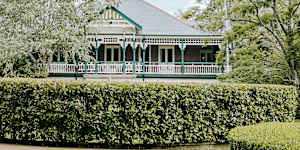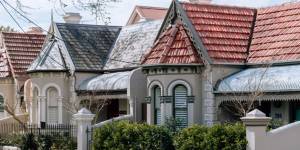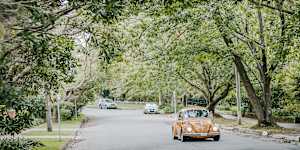The uneven recognition risks the loss of heritage in poorer parts of Sydney while maintaining and increasing the value of properties in affluent pockets,experts said.

Ku-ring-gai Council suburb Turramurra has heritage homes dating from the late 1800s.Vaida Savickaite
Far-flung areas are almost bereft of any heritage listed homes and some western Sydney councils have no local conservation areas.
Some councils are spending up to $15,000 in grants to homeowners for upkeep of these privately owned heritage homes.
Experts say the concentration of heritage listings can prevent more housing being built in well-located,liveable suburbs and risks pushing new development into outer city areas that may turn “slum-like”.
The City of Sydney leads with the estimated number of privately owned residential heritage properties at 3181, shows.

The Inner West Council,which has 2036 heritage homes is second,followed by North Sydney Council,at 1455 and Ku-ring-gai Council with 930.
These same councils also have the highest number of local conservation areas and total heritage items,which include features as simple as fences and cover large parts of council regions that are often close to existing amenities such as transport,parks and open space.
The City of Sydney has 75 conservation areas and a total of 2309 heritage-listed items. The Inner West Council has 107 conservation areas and a total of 1785 heritage-listed items.

Ku-ring-gai has 52 conservation areas,which covers more than 3939 properties – or approximately 10 per cent of all properties – within the council area,and a total of 987 heritage items.
There can be more houses than total listings because one listing can include groups of up to 44 homes.
While City of Ryde has only 161 privately owned heritage properties,it offers the largest amount in cash grants — up to $15,000 — to help homeowners maintain their homes. Their funding is capped at $500,000 in total per year.
Ku-ring-gai funds between $1000 up to $5000 grants to homeowners,spending about $52,000 in 2021,according to the council’s.
Liverpool and Fairfield city councils have fewer than 50 heritage listed houses and no heritage conservation areas at all. Nor does Blacktown City Council.

The inner-west council suburb of Annandale is an area with many heritage-listed homes.Vaida Savickaite
University of Sydney associate professor of architecture,design and planning Dr Cameron Logan said there were inequitable outcomes in preservation of heritage homes in Sydney.
“There are large inequities in the system. Heritage is encircled by property so the interest of property and power will be partly expressed through the heritage systems just as other aspects of the land use planning system,” Logan said. “In many ways,it’s an intended consequence.
“What initially looks like a constraint to build wealth in your property,the fact that you can’t build six flats,becomes a mechanism in building wealth in an area that is distinguished by its cultural quality.”
Logan said heritage value,which is often a constraint on an individual homeowner who could otherwise stand to make more money by redeveloping,can turn into economic value for a group of homeowners across a suburb.
“At some level that cultural capital can be translated into actual capital. It relies on age and shared taste value.[The properties and the areas] have acquired that value over time based on what people thought of community-based politics.”
He said the city may have not struck the right balance between protecting heritage and delivering more equitable housing and neighbourhoods.
“There are difficult trade-offs between protecting those[heritage] qualities,including at a landscape level,and achieving equitable affordable development and new housing opportunities.”
Logan said while single family home zoning was by far the biggest factor in preventing more homes from being built in Sydney,well-resourced resident action groups and councils were also preventing change through heritage listings in these same areas,he said.
”That’s become what critics would describe as NIMBYism — not focused on heritage per se but preventing change,including heritage to prevent development and hence why those areas look more like heritage.”
UNSW professor of design and architecture Robert Freestone said while the geography of heritage listings in Sydney was diverse,there was a clear contrast between the inner and outer suburbs.
“There is a broad correlation with socioeconomic status,with evidence of what Greater CitiesGeoff Roberts has dubbed the ‘latte line’ with affluence co-associated with heritage protections,” Freestone said.

He said there were a number of factors that had driven a higher concentration of Sydney heritage listings in wealthier parts of the city,including early associations between heritage and colonial history,the aristocratic connections of the early conservation movement such as the National Trust emerging in the 1940s from the Ku-ring-gai Tree Lovers Civic league,and an enduring prejudice against the “ordinariness of outer suburbia”.
Western Sydney University associate professor of geography,tourism and planning Dr Awais Piracha said the city’s concentration of heritage homes allowed for some suburbs to go untouched while others took on the burden of new housing targets.
“The west,where most of the dwellings are going,is almost turning slum-like. The sort of things we see in places like Paris,where you have all these elegant areas,and then you have all the areas that are slum-like,” Piracha said.
Affluent pockets of Sydney maintain heritage to avoid any change in character but that comes at a cost for other Sydneysiders,he said.
”Maintaining these[heritage] properties among other properties makes the area very attractive,very low density,close to amenities. That is a very desirable mix for the property owners,but for the city overall it may not be the best,” Piracha said.
“If heritage is so important,why is it only important in the east or the north?
“The west has lost lots of heritage-listed properties that would have been invaluable. The planning system is applied inequitably between the east and north and the west.”
A Ku-ring-gai council spokesperson said the community had a long history of advocating to conserve the built and natural environment,and their grants were an incentive to support owners to conserve,protect or improve significant features of listed properties.
A City of Sydney spokesperson said the history and culture of the NSW capital spanned the colonial,Victorian and federation periods through to the 21st century,eras that are reflected in local buildings that contribute to the city’s liveability,environment,and economy. They added that these are some of the densest suburbs in Sydney.

Experts say heritage listings have helped some homeowners keep their suburbs low density,maintain good amenities and retain leafy,liveable neighbourhoods.Vaida Savickaite
A Fairfield City Council spokesperson said the low number of heritage items in the area was a consequence of the later development of the west compared to other places.
A Blacktown City Council spokesperson said they had no heritage conservation areas “because there are no areas in the city that warrant the creation of a heritage conservation area”.
Blacktown City Mayor Tony Bleasdale OAM said his council was home to historical landmarks,including St Bartholomew’s Church,Minchinbury Winery and the Royal Cricketers Arms Hotel.
A Sutherland Shire Council spokesperson said unlike inner-city councils and historic regional centres,widespread suburban development did not gather pace until the 1940s in the area.
“There are no neighbourhoods of Victorian or federation homes within the Sutherland Shire to which the designation of conservation zones might typically be collectively applied,” the spokesperson said.
Homeowner grants of up to $5000 are provided to homeowners in Sutherland in recognition of the fact “that owners of heritage properties often face extraordinary maintenance costs due to the need for specialist skills and materials to restore and preserve original fabric”.